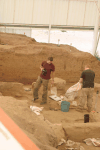
Excavated part of the city. (825k)
Çatal Höyük is a stone Age city, possibly the oldest city. The oldest layers date from about 7500 BCE. It is located south-west of the present-day city of Konya. The prehistoric settlements were abandoned before the Bronze Age. Excavations are on-going. I listened to discussions on how to excavate a layer. The Neolithic Site of Çatal Höyük is a UNESCO World Heritage Site.
Çatal Höyük is another example of the many sites of Ancient Civilizations that I visited during my travels.
From the Çatal Höyük entry in Wikipedia:
First discovered in 1958, the Çatal Höyük site was brought to worldwide attention by James Mellaart's excavations between 1961 and 1965. The site lay then idle until September 12, 1993, when investigations began under the leadership of Ian Hodder from the University of Cambridge.
The population of the eastern mound has been estimated at up to 10,000 people, but population totals likely varied over the community's history. An average population of between 5,000 to 8,000 is a reasonable estimate. The inhabitants lived in mud-brick houses which were crammed together in an agglutinative manner. No footpaths or streets were used between the dwellings, which were clustered in a honeycomb-like maze. Most were accessed by holes in the ceiling, which were reached by interior and exterior ladders. Thus, their rooftops were their streets. The ceiling openings also served as the only source of ventilation, letting in fresh air and allowing smoke from open hearths and ovens to escape. Houses had plaster interiors characterized by squared off timber ladders or steep stairs, usually placed on the south wall of the room, as were cooking hearths and ovens. Each main room served as an area for cooking and daily activities. Raised platforms built along the walls of main rooms were used for sitting, working and sleeping. These platforms, and all interior walls, were carefully plastered to a smooth finish. Ancillary rooms were used as storage, and were accessed through low entry openings from main rooms. All rooms were kept scrupulously clean. Archaeologists identified very little trash or rubbish within the buildings, but found that trash heaps outside the ruins contain sewage and food waste as well as significant amounts of wood ash. In good weather, many daily activities may also have taken place on the rooftops, which conceivably formed an open air plaza. In later periods, large communal ovens appear to have been built on these rooftops. Over time, houses were renewed by partial demolition and rebuilding on a foundation of rubble— which was how the mound became built up. Up to eighteen levels of settlement have been uncovered.
The people of Çatal Höyük buried their dead within the village. Human remains have been found in pits beneath the floors, and especially beneath hearths, the platforms within the main rooms and under the beds. The bodies were tightly flexed before burial, and were often placed in baskets or wrapped in reed mats. Disarticulated bones in some graves suggest that bodies may have been exposed in the open air for a time before the bones were gathered and buried. In some cases, graves were disturbed and the individual's head removed from the skeleton. These heads may have been used in ritual, as some were found in other areas of the community. Some skulls were plastered and painted with ochre to recreate human-like faces, a custom more characteristic of Neolithic sites in Syria and at Neolithic Jericho than at sites closer by.
Vivid murals and figurines are found throughout the settlement, on interior and exterior walls. Predominant images include men with erect phalluses, groups of men in hunting scenes, and red images of the now extinct aurochs and stags, and vultures swooping down on headless figures. Heads of animals were mounted on walls. A painting of the village with the twin peaks of Hasan Dağ in the background is currently credited as the world's oldest map and/or the first landscape painting. In addition, distinctive clay figurines of women have been found in the upper levels of the site. Although no identifiable temples have been found, the graves, murals and figurines suggest that the people of Çatal Höyük had a religion that was rich in symbol. Rooms with concentrations of these items may have been shrines or public meeting areas. The people appear to have lived relatively egalitarian lives with no apparent social classes, as no houses with distinctive features (belonging to kings or priests, for example) have been found so far. The most recent investigations also reveal little social distinction based on gender, with both men and women receiving equivalent nutrition and apparently having relatively equal social status.
In upper levels of the site, it becomes apparent that the people of Çatal Höyük were gaining skills in agriculture and the domestication of animals. Female figurines have been found within bins used for storage of cereals such as wheat and barley. Peas were also grown, and almonds, pistachios, and fruit were harvested from trees in the surrounding hills. Sheep were domesticated and evidence suggests the beginning of cattle domestication as well. However, hunting continued to be a major source of meat for the community. The making of pottery and the construction of obsidian tools were major industries. Obsidian tools were probably both used and traded for items such as Mediterranean sea shells and flint from Syria.
All pictures are © Dr. Günther Eichhorn, unless otherwise noted.







This page contains 7 pictures

Main page for Türkiye Cumhurieti (Turkey)
Page last updated on Tue Nov 2 16:12:20 2021 (Mountain Standard Time)
Page last updated on Thu Apr 25 00:27:58 2024 (Mountain Standard Time)
Çatal Höyük on aerobaticsweb.org